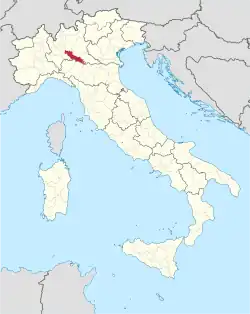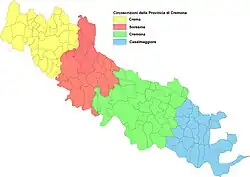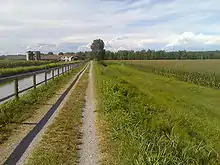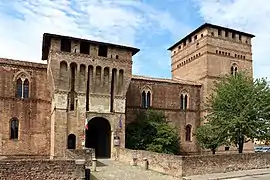Province of Cremona | |
|---|---|
 Typical canal in the countryside of Pandino | |
 Flag  Coat of arms | |
 Map highlighting the location of the province of Cremona in Italy | |
| Country | |
| Region | Lombardy |
| Capital(s) | Cremona |
| Comuni | 113 |
| Government | |
| • President | Paolo Signoroni (PD) |
| Area | |
| • Total | 1,770.46 km2 (683.58 sq mi) |
| Population (30 April 2017) | |
| • Total | 358,908 |
| • Density | 200/km2 (530/sq mi) |
| GDP | |
| • Total | €10.294 billion (2015) |
| • Per capita | €28,513 (2015) |
| Time zone | UTC+1 (CET) |
| • Summer (DST) | UTC+2 (CEST) |
| Postal code | 26100, 26010-26049 |
| Telephone prefix | 0372, 0373, 0374, 0375, 0363 |
| Vehicle registration | CR |
| ISTAT | 019 |
The province of Cremona (Italian: provincia di Cremona; Cremunés: pruvìncia de Cremùna; Cremasco: pruìnsa de Cremùna; Casalasco-Viadanese: pruvìncia ad Cramòna) is a province in the Lombardy region of Italy. Its capital city is Cremona.
The province occupies the central section of Padana Plain, so the whole territory is flat, without any mountains or hills, crossed by several rivers, such as the Serio and Adda, and artificial canals, most of which are used for irrigation.
The river Po, which is the longest Italian river, is the natural boundary with the adjoining province of Piacenza, while the Oglio separates the province from Brescia.
History
Lombardy has been inhabited since ancient times and Stone Age and Bronze Age rock drawings and artefacts have been found there. From the fifth century BC, Gallic tribes invaded and settled in the region, building several cities (including Milan) and ruling the land as far as the Adriatic Sea. From the third century BC the Romans expanded their sphere of influence into the area, and in 194 BC, the whole of what is now Lombardy, became a Roman province called Gallia Cisalpina. The Romans overwhelmed the previous civilisations and Lombardy became one of the richest and best-developed areas in Italy. It was here in 313 AD that the Roman Emperor Constantine the Great issued the famous Edict of Milan that gave freedom of religion to all people in the Roman Empire.[2]
Following the collapse of the Western Roman Empire, Lombardy was invaded by successive waves of tribes, the last of which was the Germanic Lombards in the late sixth century. Stability followed until 774, when the Frankish king Charlemagne conquered the area and annexed the Kingdom of the Lombards (most of northern and central Italy) to his empire.[3]
Geography

The province of Cremona is a long, relatively narrow part of the Padana Plain in northern Italy, the outline of which is circumscribed by rivers. The province is orientated from northwest to southeast. To the west of the province lies the Province of Lodi, to the northwest lies the Province of Milan, to the north lies the Province of Bergamo, to the east lies the Province of Brescia, and to the southeast lies the Province of Mantua. The region of Emilia-Romagna lies to the south, Cremona abutting onto the Province of Reggio Emilia, the Province of Parma and the Province of Piacenza.[4]
Several rivers flow across the Lombardy Plain to join the Po which runs along the southern border of the province. The Adda separates Cremona from the province of Lodi and the Oglio provides the border with the province of Mantua. Other rivers in the north of the province include the Serio and the Tormo, and the Mella makes up a short stretch of the border with the province of Brescia.[4] These rivers are linked by a network of canals which have been in place since at least the sixteenth century and are largely used for irrigation.[5] The Muzza Canal takes its water from the river Adda and irrigates the land between that river and the river Ticino, converting the plain into a fertile area with rich meadows and productive agricultural land.[6]
The total area of the province is 600 square miles (1,600 km2).[7] Although the province is essentially flat, there are some undulations in the surface formed by the varying courses of the rivers over the millennia. For historical reasons, the province is subdivided into four rural districts, centred on Crema, Soresina, Cremona and Casalmaggiore. In the north, some watercourses emerge from the ground in the "line of springs", a phenomenon of the northern Lombardy Plain, where melt-water from the Alps flows underground through porous gravelly soils before being forced to the surface when it reaches impervious, clayey ground.
The climate is largely uniform throughout the province. The annual rainfall is about 750 mm (30 in) with October and November being the wettest months and February and July being the driest. The average temperature is 1.7 °C (35 °F) in January and 24.3 °C (76 °F) in July.[8] There is often fog in winter, especially near the rivers.
Government
.jpg.webp)

.svg.png.webp)

The Province of Cremona is an administrative body of intermediate level between a municipality (comune) and Lombardy region.
The three main functions devolved to the province of Cremona are:
- local planning and zoning;
- provision of local police and fire services;
- transportation regulation (car registration, maintenance of local roads, etc.).
As an administrative institution, the province of Cremona has its own elected bodies. From 1948 to 1995 the President of the province of Cremona was chosen by the members of the Provincial Council, elected every five years by citizens. From 1995 to 2014, under provisions of the 1993 local administration reform, the President of the Province was chosen by popular election, originally every four, then every five years.
In a 2005 ruling of the European Court of Justice, the comune of Cingia de' Botti's award of a concession contract for public gas distribution services was criticised, as the contract had been awarded to a company called Padania without a competitive procurement process, contrary to EU regulations. Padania was a public-sector company owned by the province and most of the provincial comunes, including Cingia de’ Botti, but also open, at least to some degree, to private part-ownership.[9]
On 3 April 2014, the Italian Chamber of Deputies gave its final approval to the Law n.56/2014 which involved the transformation of the Italian provinces into "institutional bodies of second level". According to the 2014 reform, each province is headed by a President (or Commissioner) assisted by a legislative body, the Provincial Council, and an executive body, the Provincial Executive. President (Commissioner) and members of Council are elected together by mayors and city councilors of each municipality of the province respectively every four and two years. The Executive is chaired by the President (Commissioner) who appoint others members, called assessori. Since 2015, the President (Commissioner) and other members of the Council do not receive a salary.[10]
In each province, there is also a Prefect (prefetto), a representative of the central government who heads an agency called prefettura-ufficio territoriale del governo. The Questor (questore) is the head of State's Police (Polizia di Stato) in the province and his office is called questura. There is also a province's police force depending from local government, called provincial police (polizia provinciale).
This is a list of the Presidents of the Province since 1948:
| President | Term start | Term end | Party | |
|---|---|---|---|---|
| Giuseppe Ghisalberti | 1948 | 1970 | DC | |
| Martino Manfredi | 1970 | 1975 | DC | |
| Franco Dolci | 1975 | 1980 | PCI | |
| Renzo Rebecchi | 1980 | 1985 | DC | |
| Secondo Piazza | 1985 | 1988 | DC | |
| Vittorio Foderaro | 1988 | 1990 | DC | |
| Gian Carlo Corada | 1990 | 1995 | PDS | |
| Gian Carlo Corada | 8 May 1995 | 28 June 2004 | DS | |
| Giuseppe Torchio | 28 June 2004 | 8 June 2009 | PD | |
| Massimiliano Salini | 8 June 2009 | 21 July 2014 | PdL | |
| Carlo Vezzini[lower-alpha 1] | 13 October 2014 | 7 November 2016 | PD | |
| Davide Viola[lower-alpha 2] | 7 November 2016 | 26 August 2019 | PD | |
| Paolo Signoroni[lower-alpha 3] | 26 August 2019 | incumbent | PD |
- Notes
- ↑ Mayor of Sesto ed Uniti. He ended his mayoral term in 2016 and consequently was obliged to resign from the office of President of the province.
- ↑ Mayor of Gadesco-Pieve Delmona. He ended his mayoral term in 2019 and consequently was obliged to resign from the office of President of the province.
- ↑ Mayor of Dovera.
Economy and culture

The principal economic resources of the province of Cremona are agricultural. Rice is grown with the help of water drawn from canals.[11] Other crops include maize (corn), locally called Melegot and barley and to a lesser extent, soya and sugar beet. Grapes are cultivated and wine produced, and there is also a silk industry.[7] The farms in the province are some of the most productive in the country.[12] Other industries are quite developed, mostly in the northern zone, near Crema, where there are textiles, chemical, and mechanical factories.
Beef and dairy cattle are kept in the province. The beef serves as an ingredient for local dishes, and milk from the dairy cows is used to create traditional cheeses as well as producing butter and cream. The area is famous for its food specialities, such as nougat (Italian: torrone) and mustard. It is unclear exactly where torrone originated, but the recipe used in Cremona is the best known.[12]
The city of Cremona has a strong musical tradition. The cathedral, built in the twelfth century, provided a focus for musical activity and by the sixteenth century, the town was the musical centre of the region. Even now it attracts people to hear performances by ensembles and attend the many festivals. The Renaissance composer Marc'Antonio Ingegneri taught here, his most illustrious pupil being Claudio Monteverdi. The composer Pierre-Francisque Caroubel was born here and later moved to Wolfenbüttel in Germany to collaborate with Michael Praetorius. The town became renowned for the violins and other musical instruments that were made here (many members of the Stradivari, Amati, Guarneri and Bergonzi families of luthiers were all prominent citizens of Cremona), and was also well known for its concert bands. A band school was started here in 1864 under the auspices of the composer Amilcare Ponchielli.[12] The "traditional violin craftsmanship in Cremona" was declared an intangible cultural heritage by UNESCO in 2012.
Municipalities
Here is a list of the most populated municipalities of the province.
| Rank | Municipality | Population as of 2018 |
Area (km2) |
Density (inhabitants/km2) |
Altitude (mslm) |
|---|---|---|---|---|---|
| 1st | Cremona | 72,672 | 70.39 | 1032.4 | 45 |
| 2nd | Crema | 34,606 | 34.63 | 999.3 | 79 |
| 3rd | Casalmaggiore | 15,481 | 63.69 | 243.1 | 26 |
Municipal government
Here is a list of the municipal government in cities and towns with more than 15,000 inhabitants:
| Municipality | Mayor | Party | Executive | Term | |
|---|---|---|---|---|---|
| Cremona | Gianluca Galimberti | PD | PD • SI | 2019–2024 | |
| Crema | Fabio Bergamaschi | PD | PD • Ind | 2022–2027 | |
| Casalmaggiore | Filippo Bongiovanni | LN | FI • LN | 2019–2024 |
Quality of life
According to the European Environment Agency, in 2020 Cremona was the Italian province with the highest number of deaths caused by fine particulate matter PM 2.5 (between 150 and 200 deaths per 100,000 residents).[13] As of 2023, it was the fourth most polluted city in Europe and the first in Italy.[14]
Gallery
 Villa Medici del Vascello in San Giovanni in Croce
Villa Medici del Vascello in San Giovanni in Croce
 Central square in Casalmaggiore
Central square in Casalmaggiore Cascina a corte main entrance in Palazzo Pignano
Cascina a corte main entrance in Palazzo Pignano The castle of Pandino
The castle of Pandino Sanctuary of Madonna della Misericordia in Castelleone
Sanctuary of Madonna della Misericordia in Castelleone
References
- ↑ Regions and Cities > Regional Statistics > Regional Economy > Regional Gross Domestic Product (Small regions TL3), OECD.Stats. Accessed on 16 November 2018.
- ↑ Halsall, Paul (1 January 1996). "Galerius and Constantine: Edicts of Toleration 311/313". Internet Medieval Source Book. Fordham University. Archived from the original on 4 May 2016. Retrieved 3 October 2015.
- ↑ Wickham, Chris (1981). Early medieval Italy: central power and local society, 400–1000. Macmillan.
- 1 2 The Times Comprehensive Atlas of the World (13 ed.). Times Books. 2011. p. 76. ISBN 9780007419135.
- ↑ Greengrass, Mark (2014). Christendom Destroyed: Europe 1517–1648. Penguin Books Limited. p. 94. ISBN 978-0-241-00596-5.
- ↑ "Italian irrigation; a report on the agricultural canals of Piedmont and Lombardy". pp. 59–60. Retrieved 24 October 2015.
- 1 2 Bozman, E.F. (1966). Everyman's Encyclopaedia: Volume 4. J.M. Dent and Sons. p. 158.
- ↑ "Climate: Milan, Italy". Climatedata.eu. Retrieved 5 October 2015.
- ↑ European Sources Online, Press Release: Judgment of the Court of Justice in Case C-231/03. Consorzio Aziende Metano (Coname) v. Comune di Cingia de’ Botti. The awards by a municipality of a public service concession to a company with predominantly public share capital must comply with transparency criteria, published 21 July 2005, accessed 4 November 2022
- ↑ "Le elezioni". 25 November 2016.
- ↑ A Handbook for Travellers in Northern Italy &c. Murray. 1863. p. 145.
- 1 2 3 Massetti, Enrico (2015). Cremona in One Day. Enrico Massetti Publishing. pp. 35–38. ISBN 978-1-312-89500-3.
- ↑ "The Po Valley is among the most polluted areas in Europe".
- ↑ "European city air quality viewer".
External links
- Official website (in Italian)
